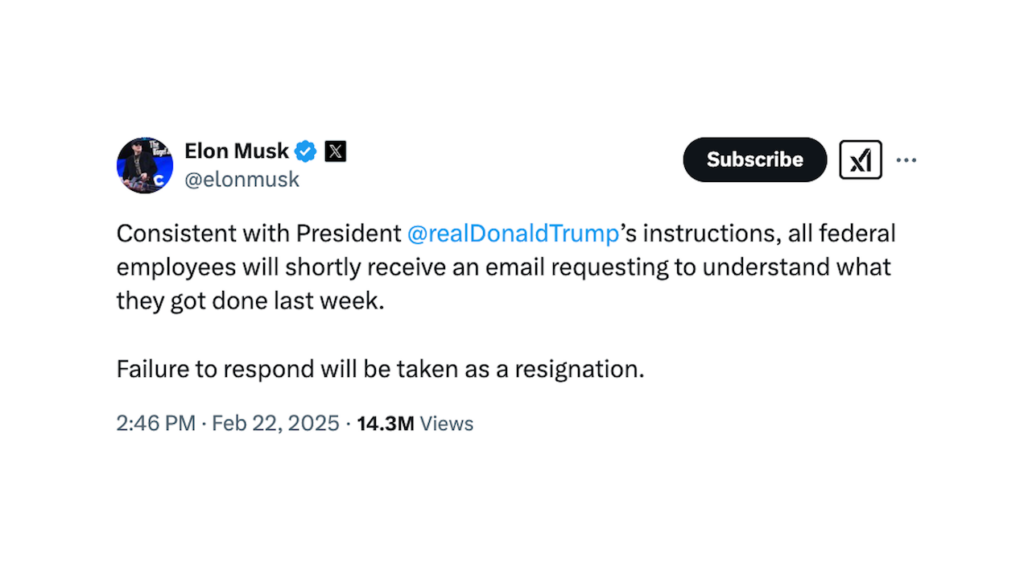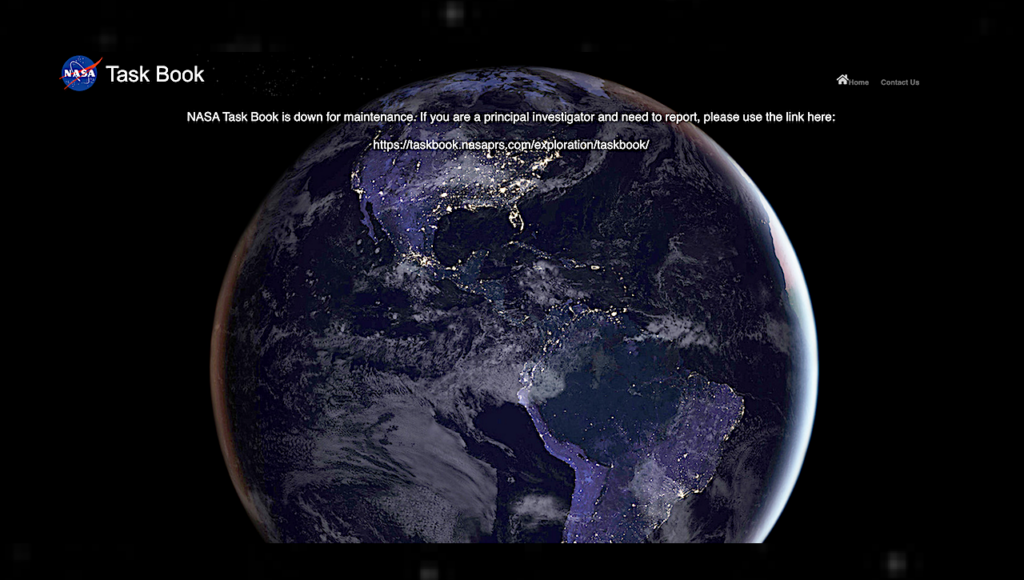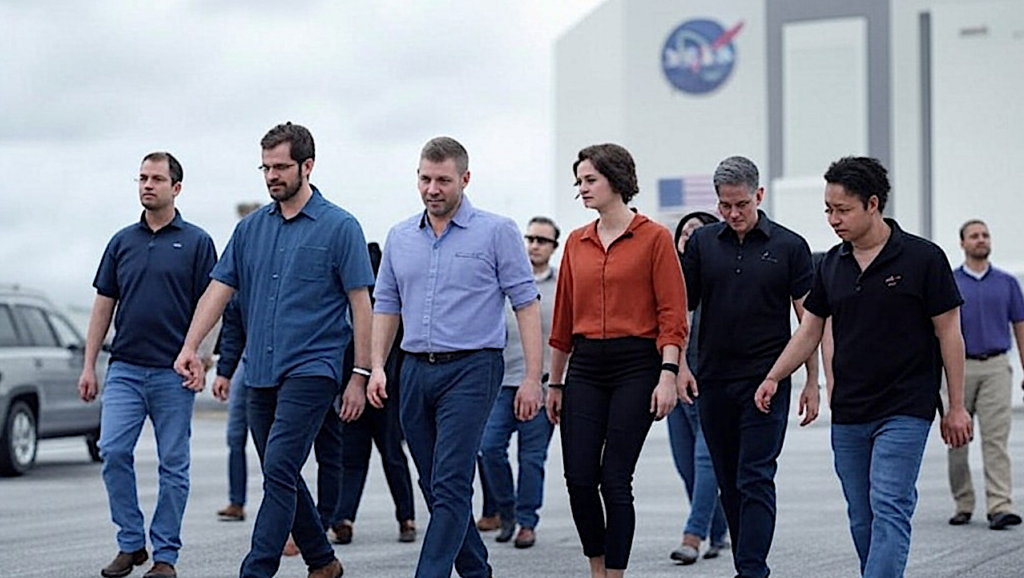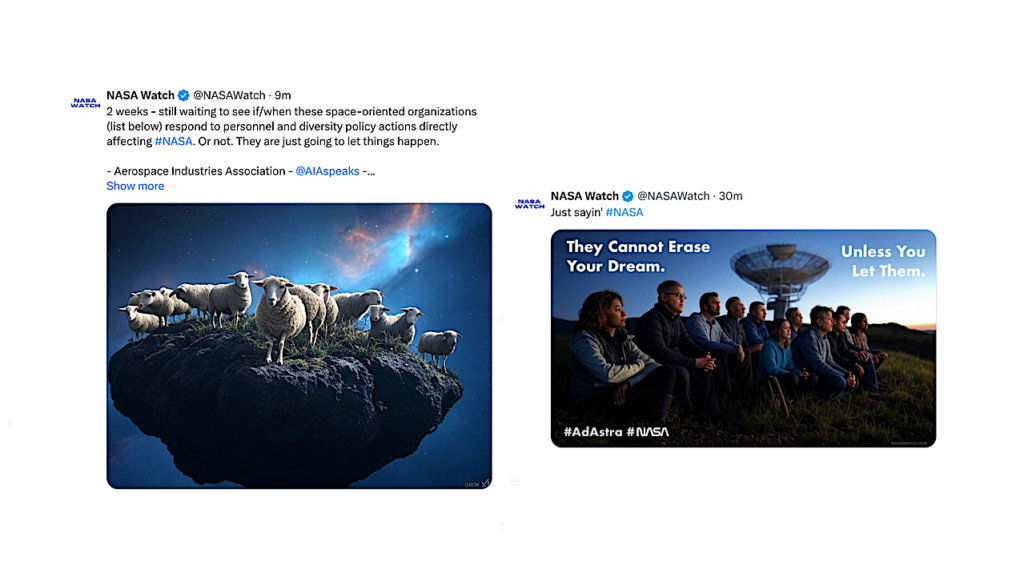New Trump Landing Team Members Announced For NASA

– Greg Autry – Employer (current or most recent): University of Southern California, Funding source: Volunteer
– Jack Burns – Employer (current or most recent): University of Colorado, Funding source: Volunteer
– Steve Cook – Employer (current or most recent): Dynetics, Inc., Funding source: Private
– Rodney Liesveld – Employer (current or most recent): National Aeronautics and Space Administration (Retired), Funding source: Volunteer
– Sandra Magnus – Employer (current or most recent): The American Institute of Aeronautics and Astronautics, Funding source: Volunteer
– Jeff Waksman – Employer (current or most recent): U.S. House of Representatives (Formerly), Funding source: Volunteer
 Keith’s note: This is the “disturbance in the Force” that I was referring to the other day. Rodney Liesveld is a pal of Chris Shank’s from Mike Griffin’s time at NASA. Steve Cook was one of Griffin’s confidants. Sandy Magnus has long-standing ties with Griffin via their positions at AIAA. The presence of Shank, Cook, Liesveld, and Magnus is further proof that Mike Griffin is lurking in the distance plotting a return to NASA. This is more of a Griffin “Boarding Party” than a “Landing Team”.
Keith’s note: This is the “disturbance in the Force” that I was referring to the other day. Rodney Liesveld is a pal of Chris Shank’s from Mike Griffin’s time at NASA. Steve Cook was one of Griffin’s confidants. Sandy Magnus has long-standing ties with Griffin via their positions at AIAA. The presence of Shank, Cook, Liesveld, and Magnus is further proof that Mike Griffin is lurking in the distance plotting a return to NASA. This is more of a Griffin “Boarding Party” than a “Landing Team”.
Adding Jack Burns, an overt lunar exploration advocate, indicates that a pivot from #JourneyToMars toward #BackToTheMoon is in the cards.
Meanwhile Rep. Jim Bridenstine is still very much in the running according to sources.









And the cycle once again repeats with the indication “that a pivot from #JourneyToMars toward #BackToTheMoon is in the cards.” One can trace these cycles and swells in enthusiasm by monitoring the LPSC abstract and participation attendance over the past 25 years (and other science funding and involvement: a publishable expose in the making). Where waves of specific program followers or hopeful financial beneficiaries produce a swell of involvement, which rises, crests and falls with the change in programs. How much time, money and potential scientists (i.e., students) have been lost in this unending change in plans, “vision” and reallocation? Time that you don’t get back, money squandered as it sustains no permanent advancement or vision – such a waste.
The problem has always been that NASA has Mars fever and so when a practical goal is established it twists it into going to Mars. VSE is the prime example, with the lunar part being minimized into just a pit stop.
Mars is as unreachable with current funding/technology as Antarctica was to the Portuguese explorers of the 15th Century. NASA needs to accept that and stop wasting money on it.
By current standards, Antarctica was unreachable in 1957. The level of risk involved in the International Geophysical Year’s Antarctic program would be unthinkable according to today’s NASA (or today’s American public.)
If we were to adopt the risk posture of 15th century Portugal, Mars would be easy for astronauts to reach.
When Columbus reached Hispaniola he immediately set about enslaving the natives and mining gold, for an almost immediate return that led quickly to a century of extraordinary wealth for Spain. If four out of five Portuguese merchant ships were lost, it was acceptable because the demand for spices was so great that the fifth ship would return from India with a cargo that would pay for them all.
In the case of the Moon and Mars, we certainly have the technology for human spaceflight but the cost is higher than any customers are willing to pay, including the US taxpayers. If manned lunar flight with Apollo technology had been sustainable, it would still be flying. It’s not.
In LEO, in contrast, it is just possible to bring the cost of human spaceflight within the range of a small but sustainable customer base of science programs and tourists.
You also forgot to include property rights. Columbus didn’t just grab slaves and look for gold. He IMMEDIATELY claimed every piece of land for the Crown of Castile. He claimed San Salvador *holy savior* on his first trip and the second trip, of 17 ships already included colonists. That would be like the second moon shot include colonists for the moon. IF we had claimed it.
The Space Resource Act codifies the necessary rights for the important element, the resources available from the Moon.
True but you do not get to own the ground, an asset that immediately goes into the ledger and can be sold, lease mineral rights, use as collateral.
Property rights will not change the economics. If the cost of access can be radically reduced (by a factor of at least ten) there may be good reasons to go to the Moon, and perhaps even Mars. At present costs there are no customers.
Yes it would,, IMMEDIATELY. If you get to claim 10,000 acres of lunar land that INSTANTLY puts an asset into your ledger.
Owning the ground is not as big an asset as you may think. The non-interference clause gives you nearly the same advantage without the liabilities associated with land ownership.
Without disagreeing, I’d say that, if the Spanish and Portuguese had insisted on no risk of fatalities and only a few percent risk of vehicle loss, the all that spice and gold wouldn’t have justified the costs. Conversely, if we, today were willing to accept losing 80% of the vehicles and a 90% crew fatality rate, the cost of a Mars mission would be much, much lower than current estimates. Arguably, enough that it would be easily affordable. (And, note, I didn’t say anything about return on investment, but that the up front costs would be affordable.)
Pointing out the obvious: those losses were acceptable admittedly in a different political milieu but mostly because there was a pot at the end of the rainbow.
Which in the case of Mars or Luna isn’t the case (as Dr. Woodard points out above).
I’m not entirely convinced the risks of 15th century (or 18th century) exploration and transatlantic travel were acceptable because of the commercial value. What we’d now call concerns for occupational health and safety were more-or-less nonexistent. That applied to activities where no large amounts of money were involved.
Yes, risks takes on a whole new perspective when the average life expectancy is only about 25 years or so. Add to that Congress Critters looking to make a name for themselves when something goes wrong and it is no wonder NASA is so risk adverse.
You also forget those expeditions were privately financed with profits coming from the monopoly rights granted to them for trade. The investment by the royalty was generally with their private funds not public funds. Public (taxpayer) funding of exploration for science really only dates to Captain Cook and only became the dominate model in the years after WWII as part of the geopolitical competition of the superpowers in the Cold War.
In short, it is not really the norm, but only seems that way to scientists raised in the post WWII era of big government funded science. The failure to continue to send astronauts to the Moon when the geopolitical justification vanishes illustrates the weakness of the government funding model.
Keen observation, incorrect conclusion.
Failure to explore the moon has nothing to do with the funding source and everything to do with the fact that there’s no reason to go.
Only Mars advocates believe that because they are so scared that discoveries on the Moon will take money and interest away from Mars. There zero sum game mentality that has set NASA back for the last generation.
NASA ignoring the Moon is why the discovery of water on the Moon was delayed by decades. One wonders what other major discoveries would be made on the Moon if there was a fleet of modern spacecraft orbiting it and roving on its surface as with Mars.
For reference on Vasco da Gama first voyage an estimated 170 left Portugal, only 55 returned. That was a far higher rate than polar exploration. In Admiral Byrd took pride in not losing anyone on his first three expeditions.
What would be that ‘commercial interest’?
Firms like Astrobotic, Moon Express, Shackleton Energy for starters. Indeed if NASA wanted to jump start lunar exploration they could just offer $200 million or so for these firms to send their rovers.
But what the Mars folks at NASA fear is that once folks see the lunar surface in live 3D HD instead of the grainy 45 year old images Mars will be forgotten. After all, what really is the purpose of going to Mars if all the best locations, and activities, are off limits because of Planetary Protection rules required by science.
OK, I’ll bite.
So let’s say that Shackleton’s scheme to go to the moon, find water, figure out how to turn the water into cryogenic H2 and O2, bottle it, ship it to LEO- let’s just say that for a moment that works, which requires, as they say, a huge suspension of disbelief, most of the tech not existing beyond a dream. And that it’s cheaper than FH, which seems to stretch credulity.
Good idea. Who buys the gas, anyway, aside fro the government?
If only the rockets had some place to go. To Mars? For what? Mars would be a huge black hole of money because there is nothing there to establish anything close to a human settlement. No trade, no dollars, no nothing.
I’m as depressed about it as Marvin.
The Virginia Company went to Virginia to mine gold and silver. They found tobacco instead. That is the difference between a free market approach and a government one. With government you need the answers before you start. With free markets you find them as you go along.
I thought we were discussing commercial interest. While I’ll accept selling something to the government as “commercial”, you start off by writing, “if NASA wanted to jump start lunar exploration they could just offer $200 million or so for these firms…” That doesn’t sound commercial.
Its as commercial at COTS and commercial crew 🙂
It’s far from rhetorical. Exactly what is the commercial interest in Luna?
And I don’t mean pie-in-the-sjy talk about H3, either, or maybe there’s water there (so what?), or maybe we beam power on microwaves.
How would anyone make money on the moon?
Yes, we would already be on Mars now if the Mars advocates hadn’t spent the last 30 years blocking lunar development. They see space exploration as starting and ending on Mars while Moon advocates see the Moon as the jumping off point to the entire Solar System.
I had the distinct pleasure of working with Jack Burns at the Lunar Science Institute. He is both an extremely competent manager and a visionary. I hope that he is given some leverage in this position to put in place the seeds for a meaningful return to the Moon.
Return to Luna how? A big monster government rocket or commercial?
Well, I guess if you involve Space-X and their ITS in the equation you might get a big monster commercial rocket, one even bigger than the big monster government rocket!
This is good news. I knew Dr. Burns when I was writing my dissertation on commercial spaceports at NMSU in 1990’s. He was very involved
with the SRS Task Force and understood well how RLVs and space commerce were paradigm breakers. I recall him talking about the potential they had for commercial lunar development as well as supporting observatories on the Moon.
If Dr. Burns is part of the team this is great news. It means that after decades of NASA being lost in the wilderness (Mars, search for ET, ISS) it will have a real direction again, not power points of what it might accomplish in a couple of decades but things it could accomplish in the next couple of Presidential Administrations.
Lunar observatories have been debunked for UV-IR astronomy. Dust is not friendly to optics. Radio is another matter. The only reason to return to Moon is to run robots remotely from Earth for some science while practicing to do same from Mars synchronous orbit. Except, when they’d be useful on Mars, AI will be able to run the show.
Even with radio, you achieve the same RF blocking with just a millimetre or so of aluminium shielding between the telescope and Earth. There’s no need for a 3400 kilometre wide moon in between.
The only reason to return to the moon is to see if there’s volatiles at the poles, and if so, whether it’s viable as fuel.
Well, Dr. Burns apparently disagrees, since he’s the PI on a Explorer proposal to do radio astronomy from lunar orbit. From the article (local newspaper, since he’s a local) it’s about cosmology and using the Moon to block terrestrial and solar interference. If you’re interested in very, very weak signals, refraction and side-lobes can be a problem. Unless the shield is huge.
And, from my own point of view, there is a great deal of interest below 5 MHz, and you can’t observe that below the Earth’s ionosphere. And, given the long wavelengths, you a big antenna (or a big array of small antennas.)
How much terrestrial radio below 5MHz penetrates the ionosphere on the way up? What is the background level in LEO?
so constellation is going to rise from the ashes with all its griffin micromanaging problems now compounded by years of SLS and Orion snail pace progress?
can we just lay out a realistic plan that actually makes tangible progress in 4 and 8 year chunks? what realistically can NASA with commercial companies and international partners achieve in one term of Trump? what is the stretch goal for 2 terms of Trump? what long term do these achievements lay the groundwork for?
“tangible progress in 4 and 8 year chunks’ Perhaps a Bigelow/Trump hotel in LEO?
Oh no, could this be the return of The Stick?
Back to the Moon? Now, why do I like that? 😉 Let’s hope that’s what we do. Not only Hickam but Heinlein would approve.
It’s worth noting that regardless of any change in official goal, NASA will be going #BackToThemMoon to the same extent that they are currently on a #JourneyToMars.
Ie, not at all. It is, and will continue to be, about the “building da big wocket!”
I like the focus on the Moon. It is what I had heard from a couple of sources. I would prefer that Michael Griffin is not involved. Constellation was unrealistic,especially the stick. The shock absorber between the stages was mind boggling that anybody thought it was a good idea to “fix” a lousy rocket design with this.